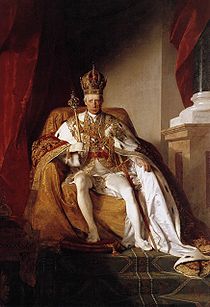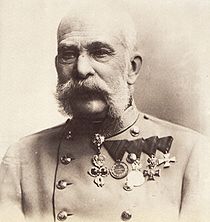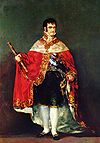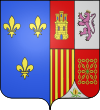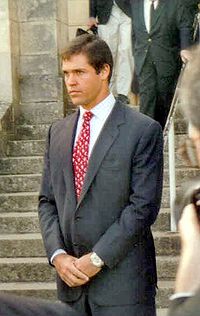
Descendants of Charles III of Spain
Encyclopedia
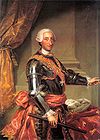
Charles III of Spain
Charles III was the King of Spain and the Spanish Indies from 1759 to 1788. He was the eldest son of Philip V of Spain and his second wife, the Princess Elisabeth Farnese...
, the third surviving son of the first Bourbon
House of Bourbon
The House of Bourbon is a European royal house, a branch of the Capetian dynasty . Bourbon kings first ruled Navarre and France in the 16th century. By the 18th century, members of the Bourbon dynasty also held thrones in Spain, Naples, Sicily, and Parma...
King
King
- Centers of population :* King, Ontario, CanadaIn USA:* King, Indiana* King, North Carolina* King, Lincoln County, Wisconsin* King, Waupaca County, Wisconsin* King County, Washington- Moving-image works :Television:...
of Spain
Spain
Spain , officially the Kingdom of Spain languages]] under the European Charter for Regional or Minority Languages. In each of these, Spain's official name is as follows:;;;;;;), is a country and member state of the European Union located in southwestern Europe on the Iberian Peninsula...
are many. Growing up in Madrid till he was 16, he was sent to the Italian
Italy
Italy , officially the Italian Republic languages]] under the European Charter for Regional or Minority Languages. In each of these, Italy's official name is as follows:;;;;;;;;), is a unitary parliamentary republic in South-Central Europe. To the north it borders France, Switzerland, Austria and...
Sovereign Duchy of Parma and Piacenza which, through his mother Elisabeth of Parma
Elisabeth of Parma
Elisabeth Farnese , the daughter of Odoardo Farnese and Dorothea Sophie of Neuburg, was Queen consort of Spain who exerted great influence over Spain's foreign policy.-Parma:Elisabeth was born at the Palazzo della Pilotta in Parma, the capital of a duchy which had been ruled by...
, was considered as his birth right. Charles married only once; he married the cultured Princess Maria Amalia of Saxony
Maria Amalia of Saxony
Maria Amalia of Saxony was a German princess from the House of Wettin and was the wife of Charles III of Spain; she was the Queen consort of Naples and Sicily from 1738 till 1759 and then Queen consort of Spain from 1759 until her death in 1760...
with whom he had 13 children with; 8 of these reached adulthood and a further 4 of them had issue.
His descendants also founded several cadet houses; the House of Bourbon-Two Sicilies
House of Bourbon-Two Sicilies
The House of Bourbon-Two Sicilies is a cadet Italian branch of the House of Bourbon. It is thus descended from the Capetian dynasty in male line...
in the Kingdom of the Two Sicilies
Kingdom of the Two Sicilies
The Kingdom of the Two Sicilies, commonly known as the Two Sicilies even before formally coming into being, was the largest and wealthiest of the Italian states before Italian unification...
, as well as descendants of the House of Bourbon-Parma
House of Bourbon-Parma
The House of Bourbon-Parma is an Italian cadet branch of the House of Bourbon. It is thus descended from the Capetian dynasty in male line. The name of Bourbon-Parma comes from the main name and the other from the title of Duke of Parma....
(founded by his younger brother Philip, Duke of Parma
Philip, Duke of Parma
Philip of Spain was Duke of Parma from 1748 to 1765. He founded the House of Bourbon-Parma , a cadet line of the Spanish branch of the dynasty...
) in the Duchy of Parma
Duchy of Parma
The Duchy of Parma was created in 1545 from that part of the Duchy of Milan south of the Po River, as a fief for Pope Paul III's illegitimate son, Pier Luigi Farnese, centered on the city of Parma....
and the House of Orléans-Braganza in the Empire of Brazil. This article deals with the children of Philip V and in turn their senior descendants.
Background of Charles
The future Charles III (Real Alcázar de Madrid, MadridMadrid
Madrid is the capital and largest city of Spain. The population of the city is roughly 3.3 million and the entire population of the Madrid metropolitan area is calculated to be 6.271 million. It is the third largest city in the European Union, after London and Berlin, and its metropolitan...
, Kingdom of Spain
Spain
Spain , officially the Kingdom of Spain languages]] under the European Charter for Regional or Minority Languages. In each of these, Spain's official name is as follows:;;;;;;), is a country and member state of the European Union located in southwestern Europe on the Iberian Peninsula...
, 20 January 1716 – Royal Palace of Madrid, Madrid, Kingdom of Spain, 14 December 1788) was the King of Spain and the Spanish Indes from 1759 to his death in 1788.
Eldest son of Philip V of Spain
Philip V of Spain
Philip V was King of Spain from 15 November 1700 to 15 January 1724, when he abdicated in favor of his son Louis, and from 6 September 1724, when he assumed the throne again upon his son's death, to his death.Before his reign, Philip occupied an exalted place in the royal family of France as a...
and his second wife, Princess Elisabeth of Parma
Elisabeth of Parma
Elisabeth Farnese , the daughter of Odoardo Farnese and Dorothea Sophie of Neuburg, was Queen consort of Spain who exerted great influence over Spain's foreign policy.-Parma:Elisabeth was born at the Palazzo della Pilotta in Parma, the capital of a duchy which had been ruled by...
, he became the Duke of Parma and Piacenza under the name of Charles I (at the death of his great uncle Antonio Farnese
Antonio Farnese, Duke of Parma
Antonio Farnese was the eighth and ultimate Farnese Duke of Parma and Piacenza. He married, in 1727, Enrichetta d'Este of Modena with the intention of begetting an heir; the marriage, however, was childless, leading to the succession of Charles of Spain–whose mother, Elisabeth Farnese, was...
); later on in 1734 while Duke of Parma he conquered the Kingdoms of Naples and Sicily and was thus created the King of Naples and Sicily due to a personal union; he ruled under the simple name of Charles with no specific numeration even though time has made him Charles VII of Naples and Charles V and Sicily. In Sicily, he was known as Charles III of Sicily and of Jerusalem; using the ordinal one III rather than V for the Sicilian people did not recognise as their sovereign legitimate one or Charles I of Naples (Charles d'Anjou), against whom they rebelled, nor the Emperor Charles, quickly discharged of the island. He was crowned King of Naples and Sicily at Palermo
Palermo
Palermo is a city in Southern Italy, the capital of both the autonomous region of Sicily and the Province of Palermo. The city is noted for its history, culture, architecture and gastronomy, playing an important role throughout much of its existence; it is over 2,700 years old...
, Sicily
Sicily
Sicily is a region of Italy, and is the largest island in the Mediterranean Sea. Along with the surrounding minor islands, it constitutes an autonomous region of Italy, the Regione Autonoma Siciliana Sicily has a rich and unique culture, especially with regard to the arts, music, literature,...
on 3 July 1735.
After becoming the King of Spain by default, he left the Neapolitan and Sicilian kingdoms to his third surviving son who was later Ferdinand IV of Naples; Ferdinand III of Sicily
Ferdinand I of the Two Sicilies
Ferdinand I reigned variously over Naples, Sicily, and the Two Sicilies from 1759 until his death. He was the third son of King Charles III of Spain by his wife Maria Amalia of Saxony. On 10 August 1759, Charles succeeded his elder brother, Ferdinand VI, as King Charles III of Spain...
; Ferdinand would see the creation of the future Kingdom of the Two Sicilies
Kingdom of the Two Sicilies
The Kingdom of the Two Sicilies, commonly known as the Two Sicilies even before formally coming into being, was the largest and wealthiest of the Italian states before Italian unification...
which would be ruled by Charles' descendants till 1861.
He was a proponent of enlightened absolutism
Enlightened absolutism
Enlightened absolutism is a form of absolute monarchy or despotism in which rulers were influenced by the Enlightenment. Enlightened monarchs embraced the principles of the Enlightenment, especially its emphasis upon rationality, and applied them to their territories...
.
| Family of Charles in 1743 | |||||||||||||||||||||||||||||||||||||||||||||||||||||||||||||||||
|---|---|---|---|---|---|---|---|---|---|---|---|---|---|---|---|---|---|---|---|---|---|---|---|---|---|---|---|---|---|---|---|---|---|---|---|---|---|---|---|---|---|---|---|---|---|---|---|---|---|---|---|---|---|---|---|---|---|---|---|---|---|---|---|---|---|

Maria Amalia of SaxonyShe was born at the ZwingerZwinger The Zwinger is a palace in Dresden, eastern Germany, built in Baroque style. It served as the orangery, exhibition gallery and festival arena of the Dresden Court.... Palace Palace A palace is a grand residence, especially a royal residence or the home of a head of state or some other high-ranking dignitary, such as a bishop or archbishop. The word itself is derived from the Latin name Palātium, for Palatine Hill, one of the seven hills in Rome. In many parts of Europe, the... in Dresden Dresden Dresden is the capital city of the Free State of Saxony in Germany. It is situated in a valley on the River Elbe, near the Czech border. The Dresden conurbation is part of the Saxon Triangle metropolitan area.... , the daughter of Augustus III of Poland Augustus III of Poland Augustus III, known as the Saxon ; ; also Prince-elector Friedrich August II was the Elector of Saxony in 1733-1763, as Frederick Augustus II , King of Poland and Grand Duke of Lithuania in 1734-1763.-Biography:Augustus was the only legitimate son of Augustus II the Strong, Imperial Prince-Elector... , Elector of Saxony and Maria Josepha Maria Josepha of Austria Maria Josepha of Austria was born an Archduchess of Austria, and from 1711 to 1713 was heiress presumptive to the Habsburg Empire... , herself daughter of Joseph I, Holy Roman Emperor Joseph I, Holy Roman Emperor Joseph I , Holy Roman Emperor, King of Bohemia, King of Hungary, King of the Romans was the elder son of Emperor Leopold I and his third wife, Eleonor Magdalene of Neuburg.... . Her full name was Maria Amalia Christina Franziska Xaveria Flora Walburga von Sachsen. One of 15 children, she was the sister of Frederick Christian, Elector of Saxony Frederick Christian, Elector of Saxony Frederick Christian, Elector of Saxony was the Prince-Elector of Saxony for less than three months in 1763... , In 1737 Maria Amalia became engaged to the future Charles III of Spain Charles III of Spain Charles III was the King of Spain and the Spanish Indies from 1759 to 1788. He was the eldest son of Philip V of Spain and his second wife, the Princess Elisabeth Farnese... . The marriage date was confirmed on 31 October 1737. In 1738, at the age of 14, Maria Amalia married Charles of Bourbon Charles III of Spain Charles III was the King of Spain and the Spanish Indies from 1759 to 1788. He was the eldest son of Philip V of Spain and his second wife, the Princess Elisabeth Farnese... , then King of Naples and Sicily. Despite the fact that this was an arranged marriage, the couple was very close and had many children. Maria Amalia had a proxy ceremony at Dresden Dresden Dresden is the capital city of the Free State of Saxony in Germany. It is situated in a valley on the River Elbe, near the Czech border. The Dresden conurbation is part of the Saxon Triangle metropolitan area.... in May 1738 with her brother. The couple met for the first time on 19 June 1738 at Portella.  Ferdinand VI of Spain Ferdinand VI , called the Learnt, was King of Spain from 9 July 1746 until his death. He was the fourth son of the previous monarch Philip V and his first wife Maria Luisa of Savoy... was displaying the same symptoms of depression that his their father used to suffer from. Ferdinand lost his devoted wife, Infanta Barbara of Portugal Barbara of Portugal Barbara of Portugal was an Infanta of Portugal and later Queen of Spain as wife of Ferdinand VI of Spain.-Life in Portugal:... in August 1758 and would fall into deep morning for her. He named Charles his heir on 10 December 1758 before leaving Madrid to stay at Villaviciosa de Odón where he died on 10 August 1759. In September 1760, a year after arriving in Madrid, Maria Amalia died from tuberculosis Tuberculosis Tuberculosis, MTB, or TB is a common, and in many cases lethal, infectious disease caused by various strains of mycobacteria, usually Mycobacterium tuberculosis. Tuberculosis usually attacks the lungs but can also affect other parts of the body... at the Buen Retiro Palace Buen Retiro Palace Buen Retiro Palace in Madrid was a large palace complex designed by the architect Alonso Carbonell and built on the orders of Philip IV of Spain as a secondary residence and place of recreation . It was built in what was then the eastern limits of the city of Madrid... outside the capital. She was buried at the Royal Crypt in El Escorial El Escorial The Royal Seat of San Lorenzo de El Escorial is a historical residence of the king of Spain, in the town of San Lorenzo de El Escorial, about 45 kilometres northwest of the capital, Madrid, in Spain. It is one of the Spanish royal sites and functions as a monastery, royal palace, museum, and... . She was joined by her devoted husband in 1788. Princess Maria IsabelMaria Isabel Antonietta de Padua Francisca Januaria Francisca de Paula Juana Nepomucena Josefina Onesifora of Naples and Sicily was born at the Palace of PorticiPalace of Portici The Royal Palace of Portici is a former royal palace in Portici, southern Italy. Today it is the home of the Orto Botanico di Portici. The Botanic Gardens are operated by the University of Naples Federico II... , Portici Portici Portici is a town and comune of the Province of Naples in the Campania region of southern Italy. It is the site of the Portici Royal Palace.-Geography:... , Modern Italy, 6 September 1740, she died in Naples Naples Naples is a city in Southern Italy, situated on the country's west coast by the Gulf of Naples. Lying between two notable volcanic regions, Mount Vesuvius and the Phlegraean Fields, it is the capital of the region of Campania and of the province of Naples... on 2 November 1742. Due to being a male line descendant of Philip V of Spain (paternal grandfather) she was an Infanta of Spain. Princess Maria JosefaBorn Princess Maria Josefa Antonietta of Naples and Sicily at the Palace of Portici on 20 January 1742 she later died in Naples on 1 April 1742. She was an Infanta of Spain.Princess Maria Isabel AnaPrincess Maria Isabel Ana was born at the Palace of CapodimonteMuseo di Capodimonte The National Museum of Capodimonte is located in the Palace of Capodimonte, a grand Bourbon palazzo in Naples, Italy. The museum is the prime repository of Neapolitan painting and decorative art, with several important works from other Italian schools of painting, and some important Ancient Roman... on 30 April 1743; the young princess died at Capodimonte on 5 March 1749 three weeks before her sixth birthday. She was an Infanta of Spain. Princess Maria JosefaPrincess Maria Josefa CarmelaInfanta Maria Josefa of Spain Maria Josefa of Spain was a Princess of Naples and Sicily by birth. At the accession of her father to the Spanish throne as Charles III, she became an Infanta of Spain. Born and raise in Naples, she arrived in Spain with her family in October 1759, at age fifteen... was born at Gaeta Gaeta Gaeta is a city and comune in the province of Latina, in Lazio, central Italy. Set on a promontory stretching towards the Gulf of Gaeta, it is 120 km from Rome and 80 km from Naples.... in Italy Italy Italy , officially the Italian Republic languages]] under the European Charter for Regional or Minority Languages. In each of these, Italy's official name is as follows:;;;;;;;;), is a unitary parliamentary republic in South-Central Europe. To the north it borders France, Switzerland, Austria and... 6 6 Year 6 was a common year starting on Friday of the Julian calendar. At the time, it was known as the Year of the Consulship of Lepidus and Arruntius... July 1744; the first of the Charkes' childrent to live past their fifth birthday, she died in Madrid Madrid Madrid is the capital and largest city of Spain. The population of the city is roughly 3.3 million and the entire population of the Madrid metropolitan area is calculated to be 6.271 million. It is the third largest city in the European Union, after London and Berlin, and its metropolitan... on 8 December 1801; despite her long life little is known of her. She was an Infanta of Spain. Princess Maria LuisaBorn at the Palace of Portici on 24 November 1745 she would die at the Imperial Palace of the HofburgHofburg Imperial Palace Hofburg Palace is a palace located in Vienna, Austria, that has housed some of the most powerful people in Austrian history, including the Habsburg dynasty, rulers of the Austro-Hungarian empire. It currently serves as the official residence of the President of Austria... in Vienna Vienna Vienna is the capital and largest city of the Republic of Austria and one of the nine states of Austria. Vienna is Austria's primary city, with a population of about 1.723 million , and is by far the largest city in Austria, as well as its cultural, economic, and political centre... , 15 May 1792 aged 46. She would marry Leopold II, Holy Roman Emperor Leopold II, Holy Roman Emperor Leopold II , born Peter Leopold Joseph Anton Joachim Pius Gotthard, was Holy Roman Emperor and King of Hungary and Bohemia from 1790 to 1792, Archduke of Austria and Grand Duke of Tuscany from 1765 to 1790. He was a son of Emperor Francis I and his wife, Empress Maria Theresa... and become the future Holy Roman Empress; Queen consort of the Romans, Hungary and Bohemia; Archduchess consort of Austria; Grand Duchess consort of Tuscany. Despite being born as Princess Maria Luisa of Naples and Sicily, her "style">changed to Infante Maria Luisa of Spain after 1759 when her father became King of Spain. She was buried at Capucins near Switzerland Switzerland Switzerland name of one of the Swiss cantons. ; ; ; or ), in its full name the Swiss Confederation , is a federal republic consisting of 26 cantons, with Bern as the seat of the federal authorities. The country is situated in Western Europe,Or Central Europe depending on the definition.... . The following line shows her direct male line descendants in the Austrian House of Habsburg which ruled Austria-Hungry till 1918. She has other descendants such as Juan Carlos I of Spain Juan Carlos I of Spain Juan Carlos I |Italy]]) is the reigning King of Spain.On 22 November 1975, two days after the death of General Francisco Franco, Juan Carlos was designated king according to the law of succession promulgated by Franco. Spain had no monarch for 38 years in 1969 when Franco named Juan Carlos as the... (through Archduke Karl Ferdinand of Austria Archduke Karl Ferdinand of Austria Archduke Karl Ferdinand of Austria-Teschen was the second son of Archduke Charles, Duke of Teschen and Henrietta of Nassau-Weilburg, and the maternal grandfather of King Alfonso XIII of Spain.A son of the "hero of Aspern" he started a military career in Infantry Regiment 57 in Brno... ), as well as Vittorio Emanuele, Prince of Naples Vittorio Emanuele, Prince of Naples Vittorio Emanuele, Prince of Naples, formerly Crown Prince of Italy is the only son of the Umberto II, the last King of Italy. He is commonly known in Italy as Vittorio Emanuele di Savoia... (through Maria Adelaide of Austria Maria Adelaide of Austria Adelaide of Austria was the first wife of Victor Emmanuel II of Sardinia, future King of Italy. She was the mother of some eight children including the future Umberto I of Italy... )...
Prince FelipePrince Felipe Antonio Genaro Pasquale Francesco de Paula of Naples and Sicily was born the first son at the Palace of Portici, 13 June 1747; titled the Duke of CalabriaDuke of Calabria Duke of Calabria was the traditional title of the heir apparent of the Kingdom of Naples after the accession of Robert of Naples. It was also adopted by the heads of certain Houses that had once claimed the Kingdom of Naples in lieu of the royal title.... , he was excluded from succession to the throne due to his imbecility; he died at the Palace of Portici, 19 September 1777 and was buried in Naples. He was an Infante of Spain. Charles IV of SpainPrince Carlos Antonio Pascual Francisco Javier Juan Nepomuceno Jose Januario Serafin Diego of Naples and Sicily
Princess Maria TeresaMaria Teresa Antonieta Francisca Javier Francisca de Paula Serafina was born at the Royal Palace of NaplesRoyal Palace (Naples) The Royal Palace is a palace in Naples, southern Italy. It is one of the four residences used by the Bourbon Kings of Naples during their rule of the Kingdom of Two Sicilies : one is in Caserta, another on the Capodimonte hill overlooking Naples, and the third is in Portici on the slopes of... , 2 December 1749; the young princess died at the Palace of Portici on 2 May 1750. She was an Infanta of Spain. Ferdinand I of the Two Sicilies |
|||||||||||||||||||||||||||||||||||||||||||||||||||||||||||||||||
| Ferdinand I Ferdinand I of the Two Sicilies Ferdinand I reigned variously over Naples, Sicily, and the Two Sicilies from 1759 until his death. He was the third son of King Charles III of Spain by his wife Maria Amalia of Saxony. On 10 August 1759, Charles succeeded his elder brother, Ferdinand VI, as King Charles III of Spain... 1816–1825 |
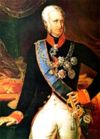 |
12 January 1751 Naples Naples Naples is a city in Southern Italy, situated on the country's west coast by the Gulf of Naples. Lying between two notable volcanic regions, Mount Vesuvius and the Phlegraean Fields, it is the capital of the region of Campania and of the province of Naples... son of Charles VII Charles III of Spain Charles III was the King of Spain and the Spanish Indies from 1759 to 1788. He was the eldest son of Philip V of Spain and his second wife, the Princess Elisabeth Farnese... and Maria Amalia of Saxony Maria Amalia of Saxony Maria Amalia of Saxony was a German princess from the House of Wettin and was the wife of Charles III of Spain; she was the Queen consort of Naples and Sicily from 1738 till 1759 and then Queen consort of Spain from 1759 until her death in 1760... |
Marie Caroline of Austria 12 May 1768 17 children Lucia Migliaccio of Floridia Lucia Migliaccio of Floridia Lucia Migliaccio, Duchess of Floridia was the second wife of Ferdinand I of the Two Sicilies. Their marriage was morganatic and Lucia was never a Queen consort.-Family:... 27 November 1814 No children |
4 January 1825 Naples Naples Naples is a city in Southern Italy, situated on the country's west coast by the Gulf of Naples. Lying between two notable volcanic regions, Mount Vesuvius and the Phlegraean Fields, it is the capital of the region of Campania and of the province of Naples... aged 73 |
|||||||||||||||||||||||||||||||||||||||||||||||||||||||||||||
| Francis I Francis I of the Two Sicilies -Biography:Francis was born in Naples, the son of Ferdinand I of the Two Sicilies and his wife Archduchess Maria Carolina of Austria. He was also the nephew of Marie Antoinette and Louis XVI the last King and Queen of France before the first French Republic.... 1825–1830 |
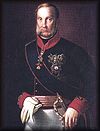 |
14 August 1777 Naples Naples Naples is a city in Southern Italy, situated on the country's west coast by the Gulf of Naples. Lying between two notable volcanic regions, Mount Vesuvius and the Phlegraean Fields, it is the capital of the region of Campania and of the province of Naples... son of Ferdinand I Ferdinand I of the Two Sicilies Ferdinand I reigned variously over Naples, Sicily, and the Two Sicilies from 1759 until his death. He was the third son of King Charles III of Spain by his wife Maria Amalia of Saxony. On 10 August 1759, Charles succeeded his elder brother, Ferdinand VI, as King Charles III of Spain... and Maria Carolina of Austria Maria Carolina of Austria Maria Carolina of Austria was Queen of Naples and Sicily as the wife of King Ferdinand IV & III. As de facto ruler of her husband's kingdoms, Maria Carolina oversaw the promulgation of many reforms, including the revocation of the ban on Freemasonry, the enlargement of the navy under her... |
Maria Isabella of Spain Maria Isabella of Spain María Isabella of Spain was an Infanta of Spain and the Queen of the Two Sicilies. She was the second wife of Francis I and the youngest surviving daughter of the Spanish king Charles IV and his consort Maria Luisa of Parma... 6 July 1802 12 children |
8 November 1830 Naples Naples Naples is a city in Southern Italy, situated on the country's west coast by the Gulf of Naples. Lying between two notable volcanic regions, Mount Vesuvius and the Phlegraean Fields, it is the capital of the region of Campania and of the province of Naples... aged 53 |
|||||||||||||||||||||||||||||||||||||||||||||||||||||||||||||
| Ferdinand II Ferdinand II of the Two Sicilies Ferdinand II was King of the Two Sicilies from 1830 until his death.-Family:Ferdinand was born in Palermo, the son of King Francis I of the Two Sicilies and his wife and first cousin Maria Isabella of Spain.His paternal grandparents were King Ferdinand I of the Two Sicilies and Queen Marie... 1830–1859 |
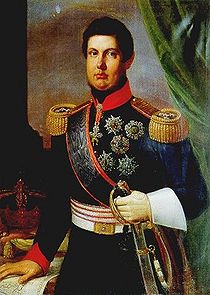 |
12 January 1810 Palermo Palermo Palermo is a city in Southern Italy, the capital of both the autonomous region of Sicily and the Province of Palermo. The city is noted for its history, culture, architecture and gastronomy, playing an important role throughout much of its existence; it is over 2,700 years old... son of Francis I Francis I of the Two Sicilies -Biography:Francis was born in Naples, the son of Ferdinand I of the Two Sicilies and his wife Archduchess Maria Carolina of Austria. He was also the nephew of Marie Antoinette and Louis XVI the last King and Queen of France before the first French Republic.... and Maria Isabella of Spain Maria Isabella of Spain María Isabella of Spain was an Infanta of Spain and the Queen of the Two Sicilies. She was the second wife of Francis I and the youngest surviving daughter of the Spanish king Charles IV and his consort Maria Luisa of Parma... |
Maria Christina of Savoy Maria Christina of Savoy Maria Cristina of Savoy was the first Queen consort of Ferdinand II of the Two Sicilies... 21 November 1832 1 child Maria Theresa of Austria Maria Theresa of Austria (1816-1867) Maria Theresa of Austria was the second wife of Ferdinand II of the Two Sicilies.-Family:She was the eldest daughter of Archduke Charles, Duke of Teschen and Henrietta of Nassau-Weilburg.... 9 January 1837 12 children |
22 May 1859 Caserta Caserta Caserta is the capital of the province of Caserta in the Campania region of Italy. It is an important agricultural, commercial and industrial comune and city. Caserta is located on the edge of the Campanian plain at the foot of the Campanian Subapennine mountain range... aged 49 |
|||||||||||||||||||||||||||||||||||||||||||||||||||||||||||||
| Francis II Francis II of the Two Sicilies Francis II , was King of the Two Sicilies from 1859 to 1861. He was the last King of the Two Sicilies, as successive invasions by Giuseppe Garibaldi and Victor Emmanuel II of Sardinia ultimately brought an end to his rule, and marked the first major event of Italian unification... 1859–1861 |
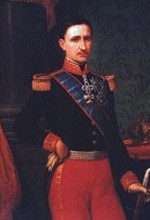 |
16 January 1836 Naples Naples Naples is a city in Southern Italy, situated on the country's west coast by the Gulf of Naples. Lying between two notable volcanic regions, Mount Vesuvius and the Phlegraean Fields, it is the capital of the region of Campania and of the province of Naples... son of Ferdinand II Ferdinand II of the Two Sicilies Ferdinand II was King of the Two Sicilies from 1830 until his death.-Family:Ferdinand was born in Palermo, the son of King Francis I of the Two Sicilies and his wife and first cousin Maria Isabella of Spain.His paternal grandparents were King Ferdinand I of the Two Sicilies and Queen Marie... and Maria Christina of Savoy Maria Christina of Savoy Maria Cristina of Savoy was the first Queen consort of Ferdinand II of the Two Sicilies... |
Maria Sophie of Bavaria 8 January 1859 1 child |
27 December 1894 Arco aged 58 |
|||||||||||||||||||||||||||||||||||||||||||||||||||||||||||||
| Prince Alfonso, Count of Caserta Prince Alfonso, Count of Caserta Prince Alfonso Maria Giuseppe Alberto of Bourbon-Two Sicilies, Count of Caserta was the third son of Ferdinand II of the Two Sicilies and Archduchess Maria Theresa of Austria.... 1894–1934 |
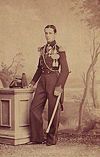 |
28 March 1841 Caserta Caserta Caserta is the capital of the province of Caserta in the Campania region of Italy. It is an important agricultural, commercial and industrial comune and city. Caserta is located on the edge of the Campanian plain at the foot of the Campanian Subapennine mountain range... son of Ferdinand II of the Two Sicilies Ferdinand II of the Two Sicilies Ferdinand II was King of the Two Sicilies from 1830 until his death.-Family:Ferdinand was born in Palermo, the son of King Francis I of the Two Sicilies and his wife and first cousin Maria Isabella of Spain.His paternal grandparents were King Ferdinand I of the Two Sicilies and Queen Marie... and Maria Theresa of Austria Maria Theresa of Austria (1816-1867) Maria Theresa of Austria was the second wife of Ferdinand II of the Two Sicilies.-Family:She was the eldest daughter of Archduke Charles, Duke of Teschen and Henrietta of Nassau-Weilburg.... |
Princess Antonietta of Bourbon-Two Sicilies 8 June 1868 12 children |
26 May 1934 Cannes Cannes Cannes is one of the best-known cities of the French Riviera, a busy tourist destination and host of the annual Cannes Film Festival. It is a Commune of France in the Alpes-Maritimes department.... aged 93 |
|||||||||||||||||||||||||||||||||||||||||||||||||||||||||||||
| Prince Ranieri, Duke of Castro Prince Ranieri, Duke of Castro Prince Ranieri Maria Gaetano, Duke of Castro was a claimant to the headship of the House of Bourbon-Two Sicilies.-Biography:... 1960–1966 |
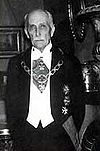 |
3 December 1883 Cannes Cannes Cannes is one of the best-known cities of the French Riviera, a busy tourist destination and host of the annual Cannes Film Festival. It is a Commune of France in the Alpes-Maritimes department.... son of Prince Alfonso, Count of Caserta Prince Alfonso, Count of Caserta Prince Alfonso Maria Giuseppe Alberto of Bourbon-Two Sicilies, Count of Caserta was the third son of Ferdinand II of the Two Sicilies and Archduchess Maria Theresa of Austria.... and Princess Antonietta of Bourbon-Two Sicilies |
Countess Maria Carolina Zamoyska Countess Maria Carolina Zamoyska Countess Maria Carolina Zamoyska was the wife of Prince Ranieri, Duke of Castro, claimant to the headship of the House of Bourbon-Two Sicilies... 12 September 1923 2 children |
13 January 1973 La Combe aged 89 |
|||||||||||||||||||||||||||||||||||||||||||||||||||||||||||||
| Prince Ferdinand, Duke of Castro Prince Ferdinand, Duke of Castro Prince Ferdinando of the Two Sicilies was a claimant to the headship of the House of the Two Sicilies. He was known as the Duke of Castro.-Biography:... 1966–2008 |
 |
28 May 1926 Podzamcze son of Prince Ranieri, Duke of Castro Prince Ranieri, Duke of Castro Prince Ranieri Maria Gaetano, Duke of Castro was a claimant to the headship of the House of Bourbon-Two Sicilies.-Biography:... and Countess Maria Carolina Zamoyska Countess Maria Carolina Zamoyska Countess Maria Carolina Zamoyska was the wife of Prince Ranieri, Duke of Castro, claimant to the headship of the House of Bourbon-Two Sicilies... |
Chantal de Chevron-Villette Chantal de Chevron-Villette Chantal Françoise Marie Camille de Chevron-Villette was the wife of Prince Ferdinand of Bourbon-Two Sicilies, Duke of Castro, claimant to the headship of the House of Bourbon-Two Sicilies... 23 July 1949 3 children |
20 March 2008 France Aged 81 |
|||||||||||||||||||||||||||||||||||||||||||||||||||||||||||||
| Prince Carlo, Duke of Castro Prince Carlo, Duke of Castro Prince Carlo of Bourbon-Two Sicilies, Duke of Castro is one of two claimants to the headship of the House of Bourbon-Two Sicilies.-Early life and education:... 2008–present |
 |
24 February 1963 Saint-Raphaël Saint-Raphaël, Var Saint-Raphaël is a commune in the Var department in the Provence-Alpes-Côte d'Azur region in southeastern France.Immediately to the west of Saint-Raphaël lies another, older, town called Fréjus, and together they form an urban agglomeration known as Fréjus Saint-Raphaël... son of Prince Ferdinand, Duke of Castro Prince Ferdinand, Duke of Castro Prince Ferdinando of the Two Sicilies was a claimant to the headship of the House of the Two Sicilies. He was known as the Duke of Castro.-Biography:... and Chantal de Chevron-Villette |
Camilla Crociani 31 October 1998 2 children |
Current claimant | |||||||||||||||||||||||||||||||||||||||||||||||||||||||||||||
Prince Gabriel
Prince Gabriel Antonio Francisco Javier Juan Nepomuceno José Serafin Pascual Salvador of Naples and Sicily was born at the Palace of Portici, 11 May 1752; married Infanta Mariana Vitória of PortugalInfanta Mariana Vitória of Portugal
Mariana Victoria of Portugal was a Portuguese Infanta , the third child and eldest daughter of Queen Maria I of Portugal and King Peter III of Portugal.-Biography:Mariana Victoria was born at the Royal Palace of Queluz, in the...
, daughter of Maria I of Portugal
Maria I of Portugal
Maria I was Queen regnant of Portugal and the Algarves from 1777 until her death. Known as Maria the Pious , or Maria the Mad , she was the first undisputed Queen regnant of Portugal...
; had three children two of which died young; died at his private residence, the Casita del Infante
Casita del Infante
The Casita del Infante is a historical building in San Lorenzo de El Escorial, Spain, constructed as a private home for the Infante Gabriel of Spain, hence its name. The small residence was built during the late 18th century during the reign of his father Charles III of Spain...
, San Lorenzo de El Escorial, Spain, 23 November 1788.
Princess Maria Ana
Born at the Palace of Portici, 3 July 1754; she died at the Palace of Capodimonte, 11 May 1755. She was an Infanta of Spain.Prince Antonio Pascual
Prince Antonio Pascual Francisco Javier Juan Nepomuceno Aniello Raimundo Sylvestre of Naples and SicilyInfante Antonio Pascual of Spain
200px|thumb|Infante Antonio Pascual, painted by [[Francisco de Goya|Goya]].Antonio Pascual de Borbón y Wettin was an infante of Spain, son of King Charles III of Spain and younger brother of King Charles IV of Spain and Ferdinand I of the Two Sicilies.-Biography:Born Antonio Pascual Francisco...
was born at the Caserta Palace
Caserta Palace
The Royal Palace of Caserta is a former royal residence in Caserta, southern Italy, constructed for the Bourbon kings of Naples. It was the largest palace and one of the largest buildings erected in Europe during the 18th century...
, 31 December 1755; he married his niece, Infanta Maria Amalia of Spain (1779-1798) in 1795 and had no issue. He died in Madrid on 20 April 1817. He is more commonly known as Infante Antonio Pascual. He was buried at El Escorial
El Escorial
The Royal Seat of San Lorenzo de El Escorial is a historical residence of the king of Spain, in the town of San Lorenzo de El Escorial, about 45 kilometres northwest of the capital, Madrid, in Spain. It is one of the Spanish royal sites and functions as a monastery, royal palace, museum, and...
.
Prince Francis
Prince Francisco Javier Antonio Pascual Bernardo Francisco de Paula Juan Nepomuceno Aniello Julian of Naples and Sicily was born at the Caserta Palace on 15 February 1757 little is known of the youngest of Charles' children but he did move to Spain with his parents in 1759; he died unmarried and without known issue at the Royal Palace of Aranjuez, Spain on 10 April 1771. He was buried at El EscorialEl Escorial
The Royal Seat of San Lorenzo de El Escorial is a historical residence of the king of Spain, in the town of San Lorenzo de El Escorial, about 45 kilometres northwest of the capital, Madrid, in Spain. It is one of the Spanish royal sites and functions as a monastery, royal palace, museum, and...
.
See also
- Descendants of Henry IV of FranceDescendants of Henry IV of FranceHenry IV of France was the first Bourbon king of France. Formerly known as Henri of Navarre, he succeeded to the French throne with the extinction of House of Valois, at the death of Henry III of France. In 1584, Prince François, the youngest brother and heir presumptive of King Henry III, died...
- Descendants of Philip V of SpainDescendants of Philip V of SpainThe descendants of Philip V of Spain, Bourbon monarch of the Kingdom of Spain, Kingdom of Naples, Kingdom of Sardinia and Kingdom of Sicily are numerous. He had two wives; by his first wife Maria Luisa of Savoy he had two children. After the death of his first wife Philip married Elisabeth of Parma...
- Bourbon Claim to the Spanish ThroneBourbon Claim to the Spanish ThroneAfter the death of the last Habsburg monarch of Spain in 1700, the degenerate Charles II, the Spanish throne was up for grabs between the various powers of Europe, despite Charles having left a will, naming his heir...


